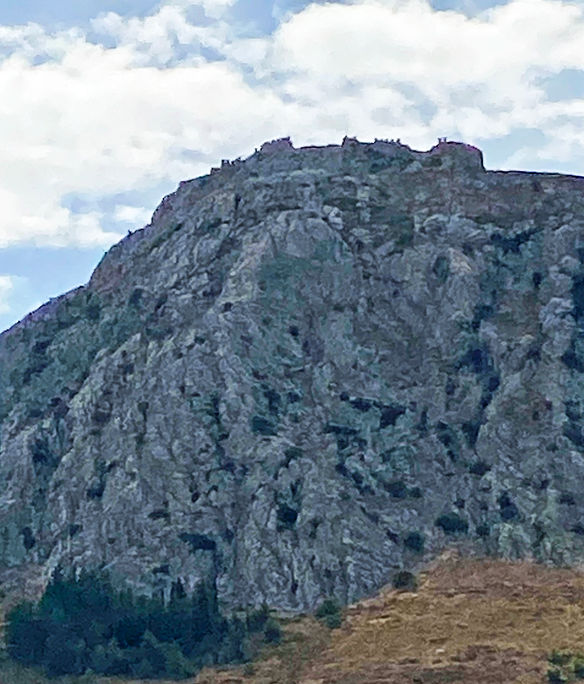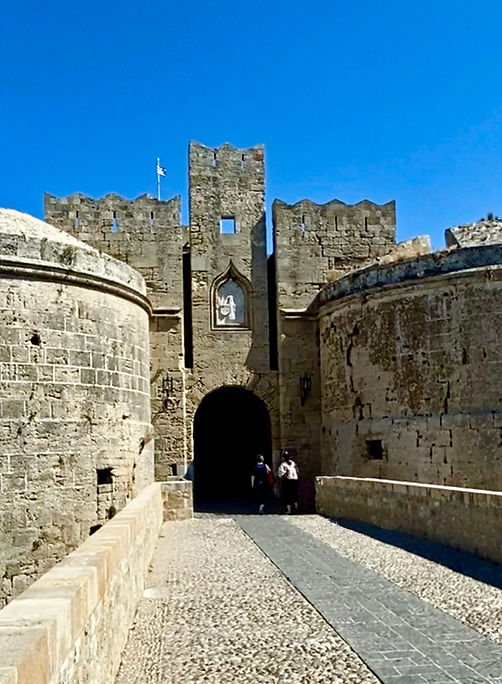
The Greekish Life
Culture
The Knights of Rhodes

Generally, when you think of Greece, any number things might come to mind; columned antiquities, bearded philosophers, lively dancing and smashing plates, or world-class beaches.
But not many people think about knights.
Knights and castles tend to be thought of as being in the domain of western Europe. And yet a traveler to Greece might be surprised to find so many remnants of medieval castles dotting the landscape, crowning mountaintops or guarding important ports. There are even whole medieval towns in Greece, walled and crenellated, which offer delightful explorations. Castles and fortresses abound if you know where to look, and they span the eras of the Byzantines, the Franks, and the Venetians and Genoese.

Lindos Acropolis, used by the Knights of St. John - Lindos, Rhodes
.jpg)
Two of the three castles in the town of Nafplio. Front-left is Acropnauplio, and top-right is the Bourtzi Castle, built by the Venetians.
.jpg)
The third castle of Nafplio, the Palamidi Fortress.
.jpg)
Inside the Palamidi Fortress.
.jpg)
Bourtzi Castle at sea-level.

The Frankish mountain stronghold of Karytaina in Arcadia.

The gate of Monemvasia. Monemvasia means "single entrance", and this is the only way to get into this fortified medieval town in Lakonia.

The eastern wall of Monemvasia.
.jpg)
The remains of a Venetian-era castle, called a "kastro" in Greek, is almost easy to miss in the town of Chora, on the island of Naxos.

The unassailable-looking Acrocorinth castle - Corinth
One place you'll find castles is Rhodes, one of the largest Greek islands, located in the Dodecanese island group. The capital, Rhodes town, is a thoroughly modern tourist town, but just beyond the modern buildings and busy traffic is the medieval city, known as the Old Town. This is surrounded by high stone walls and three dry moats, and entry to this beautiful spot frozen in time can be accessed by several impressive arched gates on all sides of the city.

The Amboise Gate
.jpg)
The Gate of St. Anthony
.jpg)
Alternately called the Sea Gate, Thalassini Gate and Marina Gate, this entrance may be the most imposing of all.
In the northwest of the Old Town, at the end of the picturesque and historic Street of the Knights (Ippoton/Ιπποτών in Greek) sits an imposing castle called the Palace of the Grand Master. It's a full-on, turreted, crenellated castle out of a medieval romance - dazzling and commanding - and not at all the sort of thing you expect to see in Greece. It's built upon the old foundations of a temple to the Sun God, Helios. (The Colossus of Rhodes, one of the ancient wonders of the world, was a statue of Helios.) It was the headquarters of the order of the Knights of St. John.



A view of one of the dry moats surrounding the walls.
The Knights of St. John, alternately called the Knights Hospitaller, the Knights of Rhodes (during their tenure there) or more formally, The Knights Hospitaller of Saint John of Jerusalem, were a Catholic military order. Their initial mission was to provide care for the sick and injured pilgrims to the Holy Land, and had set up the Hospital of St. John in Jerusalem. Later they added the military role. They used Rhodes as their base from about 1309 to 1522, when they were driven out by the Ottoman Turks and had to relocate to Malta, where they reorganized into the Order of Malta, which exists to this day.

The Hospitallers had surprisingly high standards of care, some of which would not be seen again until more modern times. They had separate, well-ventilated wards for male and female patients, with female caregivers for the women's quarters. Rooms were kept clean and airy, and the food served was said to be excellent, as the order seems to have made the connection between good, nutritious food and recovery. The poor, sick and injured were admitted regardless of their religion or nationality. There is even some evidence that they accommodated the dietary needs of non-Christian patients, which was pretty progressive for the times.
Unlike their more famous and militant rival order, the Knights Templar, the Knights Hospitaller were only supposed to take up arms in defense of those in their care. While they weren't exactly the Bloods and the Crips of the medieval world, the two orders despised each other. The Hospitallers detested the Templars as mercenaries who they felt put banking above God. Both orders jostled for power and the good graces of the Pope.
Of the two orders, only the Knights of St. John are still officially recognized by the Catholic church. The Templars were persecuted and dissolved in 1312 (officially), but apparently continue to this day on their own terms. (There is even a Templar Priory in Greece currently, and the Knights Templar of Greece have their own Facebook page.)
Along the severe and beautiful Street of the Knights, seven grand inns where constructed in the early 16th century, representing the seven countries - described as "tongues" or "langues" in French - that the various knights of the order originated from - Auvergne, Provence, France, Aragon, Germany, England and Italy. Each facade is decorated with symbols of that country. It is one of the best preserved medieval streets in all of Europe.
If you're able to catch it very early in the morning or at night without the daytime hordes of shuffling tourists, walking it really feels like time travel. You wonder who might be watching you from the mullioned windows.


As I mentioned earlier, the street runs from the Palace of the Grand Master down to what was the original Hospital at the bottom of the street. That building currently serves as the Archaeological Museum of Rhodes, which due to COVID protocols during my visit, was closed, so I was sadly unable to visit.
The official in charge of the order of St. John was the Grand Master, who was elected for life. The palace was both his private residence and the administrative center of the order. There are over 150 rooms in the massive castle, but only 24 are open to visitors, including the Grand Master's living quarters, grand reception hall and music room. Superb mosaics cover many of the floors. A cavernous stairway leads up to the second floor.





.jpg)
.jpg)
.jpg)


.jpg)

The palace was mostly destroyed in 1856, due either to an explosion in a nearby gunpowder warehouse or from explosives hidden in a church basement - sources don't seem to agree on this particular point. The palace fell into decay for decades, until just before WWII. The Italians, who seized the Dodecanese islands from the Ottomans in 1912, restored the palace, and it became a vacation stay for the Italian king Vittorio Emmanuele III and later, fascist dictator Benito Mussolini. Rhodes didn't belong to Greece again until 1948.
The Old City of Rhodes, including the Palace of the Grand Master, the Street of the Knights, and all the tiny alleyways, bustling little squares and massive gates are a must-see on this island. It's a romantic and photogenic reminder of a not-very-well-known but tremendously important time in Greek history. Go if you can - marvel at the medieval masterpieces and walk the cobbled streets with the ghosts of the knights.


Do you want to know more about Greek culture? Click here!
Like this article?
Please share it on Facebook and
pin it on Pinterest!
Leave a comment below!
.jpg)